Chapter 3 - Cells
All organisms are composed of cells
A cell is the smallest unit of life that can function independently. Being composed of cells is one of the most basic characteristics of life.
Cell Theory
Cell theory was first developed in the mid - 1800s, after it became possible to student using microscopes.
The tenets of cell theory explain commonalities of cells.
| Components of early cell theory |
|---|
| All organisms are made of one or more cells. |
| The cell is the fundamental unit of life. |
| All cells come from preexisting cells. |
| Additional ideas in modern cell theory |
| All cells have the same basic chemical composition. |
| All cells use energy. |
| All cells contain DNA that is duplicated and passed on as each cell divides. |
Most cells are too small to see without a microscope
Light microscopes are used to - view the entire cell.
- Have less magnifying power than electron microscopes
- Transmit light through cells
- Can be used to view living cells
Electron microscopes are used to - view the parts of the cells, and viruses, which are smaller and require higher magnification
A transmission electron microscope (TEM) is a very powerful tool for - seeing internal cell structures. It transmits right through cells.
A scanning electron microscope (SEM) is also very powerful and reveals - details on cell surfaces. It bounces electrons off of the surface of the cell.
All cells share common features
Regardless of size, all cells have - genetical material, ribosomes, cytoplasm, and a cell membrane
They all carry out chemical reactions needed to sustain life, such as cellular respiration and protein synthesis.
Why are cells so small?
| Prokaryote | Eukaryote | |
|---|---|---|
| Nucleus | No | Yes |
| Membrane - bounded Organelles | No | Yes |
Smaller cells have more surface area relative to their volume.
High surface area allows the cell to - quickly exchange materials with its surroundings.
For example, oxygen from the air must quickly enter your lung cell.
Life is classified into three domains
| Cell Type | Nucleus | Membrane - Bounded Organelles | Membrane Chemistry | Typical Cell Size | |
|---|---|---|---|---|---|
| Domain Bacteria | Prokaryotic | Absent | Absent | Fatty acids | 1 - 10 |
| Domain Archaea | Prokaryotic | Absent | Absent | Nonfatty acid lipids | 1 - 10 |
| Domain Eukarya | Eukaryotic | Present | Present | Fatty acids | 10 - 100 |
Prokaryotes
Prokaryotes are the - most ancient forms of life. They are small, simple in structure and lack a nucleus. Bacteria and archaea are two different domains.
- Archaea: cell membranes contains either linkages; cell walls lack peptidoglycan
- Bacteria cell membrane contains ester bond; cell wall made of peptidoglycan
Bacteria also reacts to antibiotics in a different way than archaea does.
Eukaryotes
Eukaryotes are - larger and more complex, with many internal parts including a nucleus and other membranous organelles. Protists, fungi, plants, and animals are eukaryotic.
Anatomy of cells
The anatomy of a bacterial cell
Bacteria are - prokaryotic, lack membrane - bounded organelles, and their ribosomes and DNA are free in the cytoplasm.
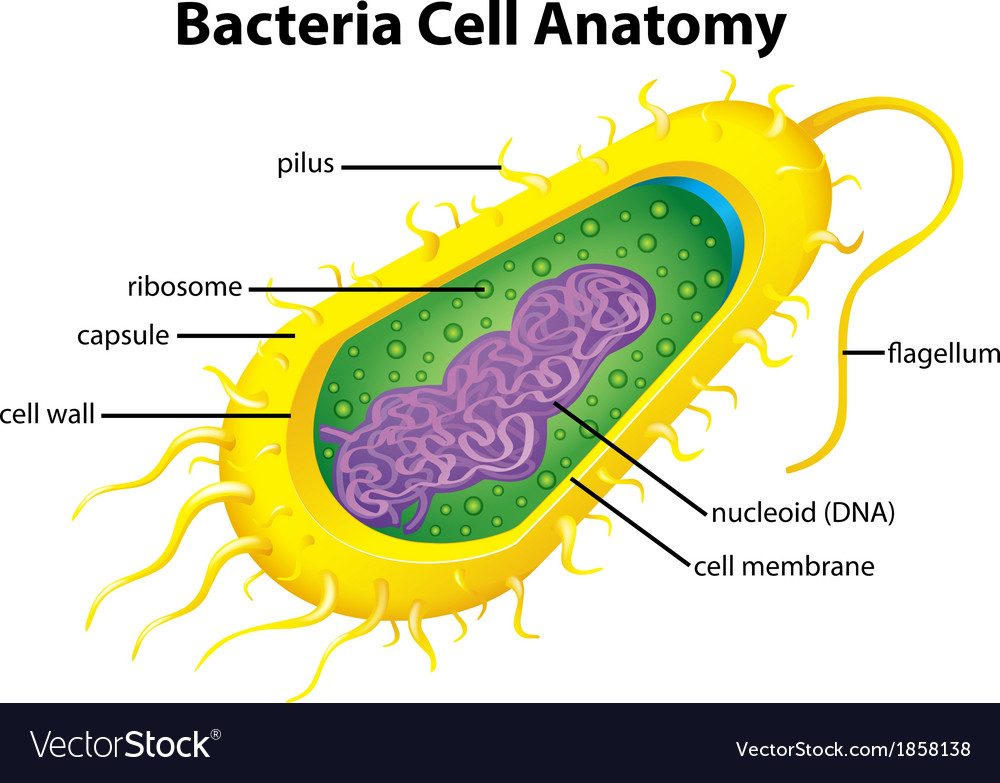 The anatomy of an animal cell
The anatomy of an animal cell
Animal cells are - eukaryotic. They have many different membrane - bounded organelles.
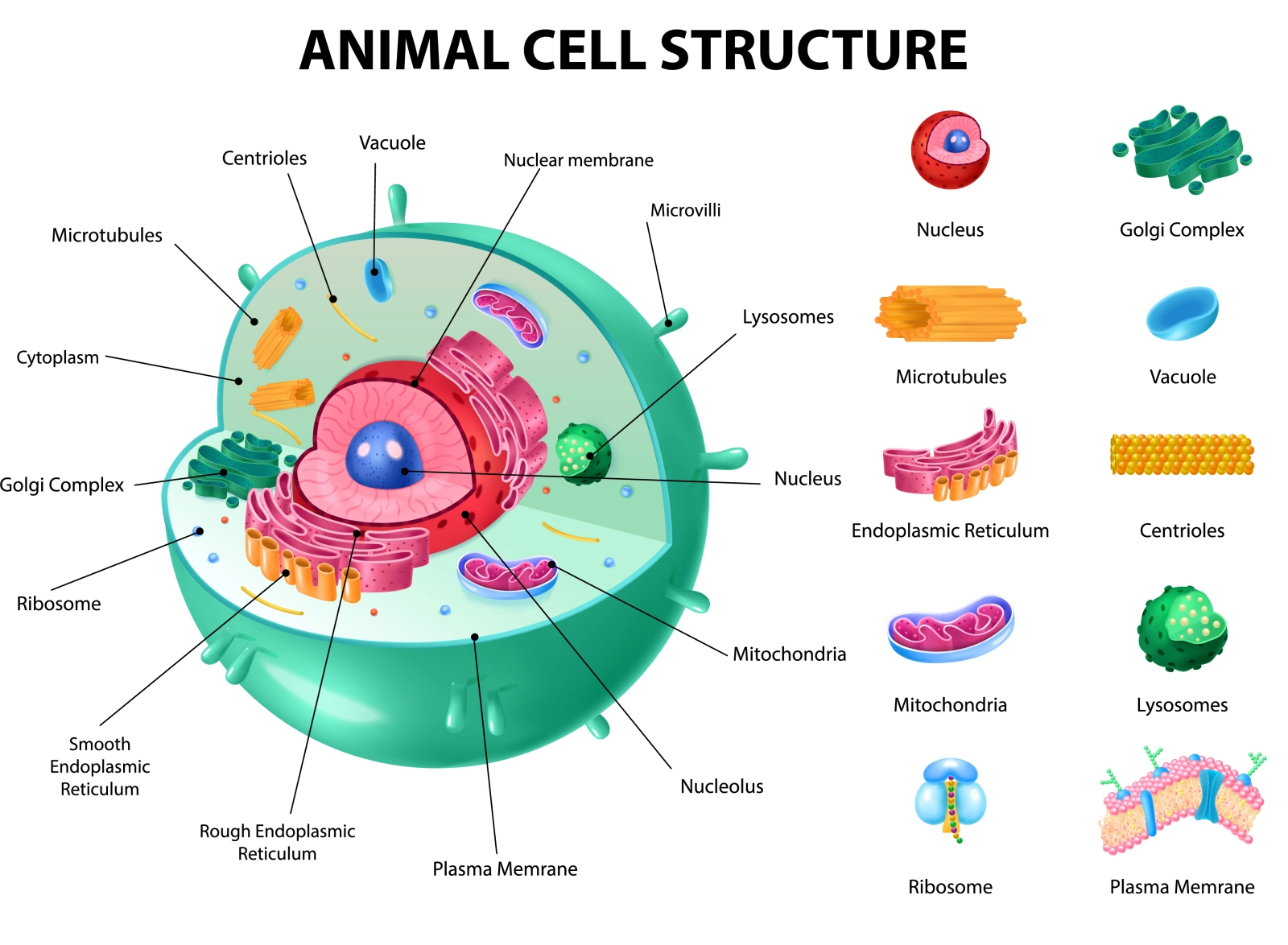 The anatomy of a plant cell
The anatomy of a plant cell
Plants are - eukaryotic. They have most of the same membrane bounded organelles as animals, but notice the large central vacuole, cell wall, and chloroplasts.
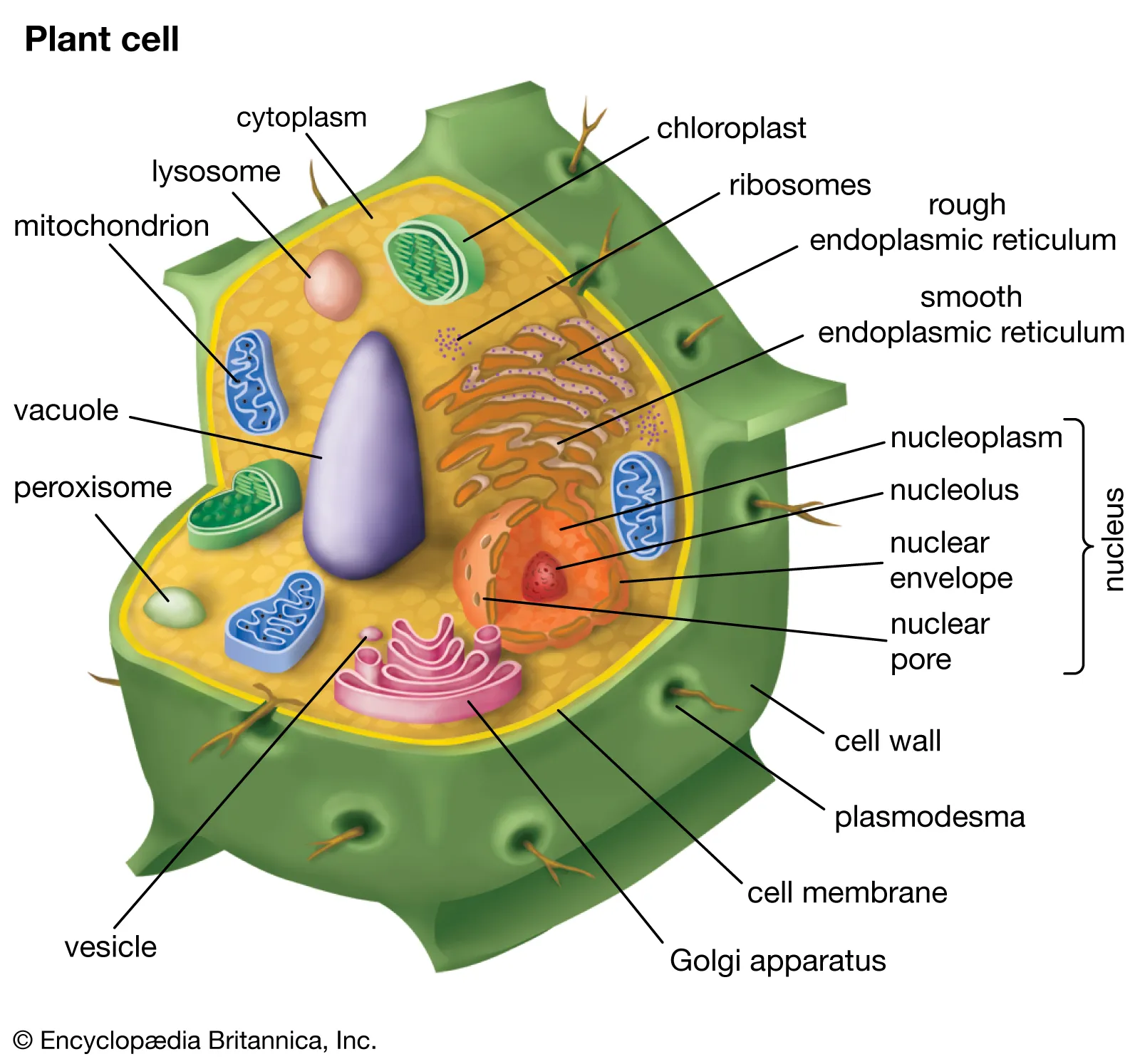 Eukaryotic cells divide the labor
Eukaryotic cells divide the labor
- [ ] Cell Membrane
- [ ] Organelles involved in protein production
- [ ] Organelles involved in protein localization
- [ ] Organelles involved in cellular digestion
- [ ] Energy - related organelles
- [ ] The cytoskeleton
Cell Membrane
A membrane surrounds each cell.
Cell membrane function - Forms a barrier between the cells and the outside world. Regulates passage of substances in and out of the cell; helps maintain homeostasis
Phospholipids make up the cell membrane
- A phospholipid is made of - a molecule of glycerol, a phosphate group, and 2 fatty acids
- Phospholipids are - amphipathic with a hydrophilic head and hydrophobic tail
- Hydrophilic head has polar bonds which are attracted to water
- Hydrophobic tails has nonpolar bonds which repel water
- Amphipathic - there are polar and nonpolar regions in the same molecule.
Cells membrane are - phospholipid bilayers
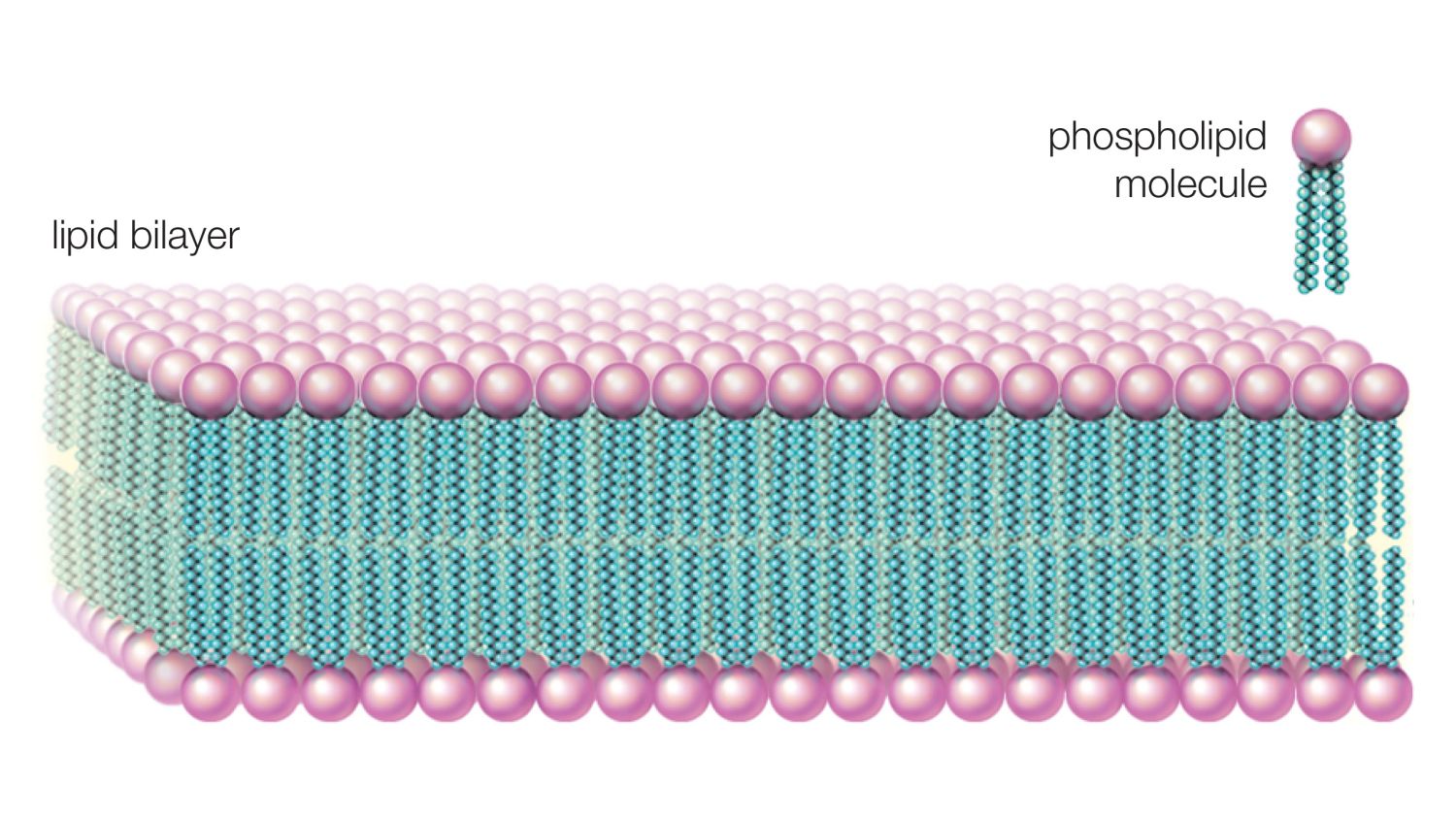
Because of their chemical structure, phospholipids spontaneously form bilayers when they are surrounded by water. It is selectively permeable to lipids and small, nonpolar molecules.
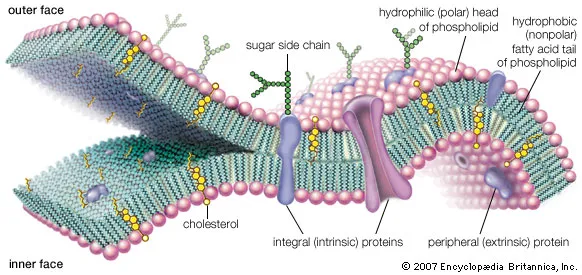
Cell membranes contain ^^proteins^^ that carry out different functions - Transport proteins, Enzymes, Recognition Proteins, Adhesion Proteins, Receptor Proteins
^^Carbohydrates^^ protrude outward from the cell membrane
- Chains are sugars are attached to some of the protein and phospholipids in cell membranes. They play roles in cell - cell communication
Cell membranes contain ^^steroids^^
- Cholesterol is an example of a membrane steroid
- The membrane steroids keep - the membrane at the right level of fluidity
Cell membranes are fluid mosaics. They are like Jell-O. In the membrane, the phospholipids are constantly moving and switching places.
Fluid mosaics - neither a solid nor a liquid
The combination of phospholipids and proteins - forms a fluid mosaic.
Organelles involved in protein production
- The nucleus - controls protein production
- Contains DNA, which specifies the “recipe” for proteins
- The nucleus contains the nucleolus - synthesizes ribosomes in protein production
- RNA is synthesized in the - nucleus
- Messenger RNA (mRNA) - matches the sequence of DNA and carries the protein “recipe” through a nuclear pore in the two - layered nuclear envelope.
RNA binds to a ribosome, where the protein is synthesized.
- Some ribosomes float in the cytosol; others are attached to the rER
Organelles involved in protein localization
The endomembrane system consists of - the nuclear envelope, endoplasmic reticulum, Golgi apparatus, lysosomes, vacuoles, and cell membrane. This moves molecules around.
The different parts of the endomembrane system work together to secrete proteins, moving outside of the cell.
- Proteins move from the ribosomes into the rER, where they are modified and folded into their exact 3D shape. The proteins exit the rER in bubbles of membrane called transport vesicles.
- The vesicles leaving the rER fuse with the Golgi apparatus (a stack of membrane sacs that acts as a “processing center”)
- Proteins leave the Golgi in transport vesicles then fuse with the cell membrane. The contents of the vesicles are expelled to the outside of the cell.
Organelles involved in cellular digestion
Lysosomes - contain hydrolytic enzymes
Some transport vesicles leaving the Golgi carry enzymes that catalyze hydrolysis reactions. These vesicles fuse with lysosomes, where cellular digestion of large molecules occurs.
- Most plant cells lack lysosomes.
- Cellular digestion occurs in central vacuoles in plant cells which also help regulate the size and water balance of plant cells.
Peroxisomes - aid in digestion
- They originate at the ER and contain enzymes that digest then oxidize certain toxic molecules
Energy - related organelles
Mitochondria - extract energy from food
- Matrix - space inside the mitochondria
- Cristae - Folds in the inner mitochondrial membrane
- These are the sites for the chemical reactions of cellular respiration
Cellular respiration - converts sugar’s energy into a form the cell can use for work
Eukaryotes that carry out photosynthesis include plants and some protists. These cells have chloroplasts.
Chloroplasts - organelles that convert energy from sunlight into glucose, which is food for the cell
- Stroma - space inside the chloroplast
- Thylakoids - flattened sacs of internal membranes inside the chloroplasts
- These are the sites for chemical reactions of photosynthesis.
The sugar travels to the mitochondria, which extract the energy used for cellular processes.
The cytoskeleton
Cytoskeleton - a network of protein tracks and tubules found in eukaryotic cells. Its functions are structural support, aids in cell division, organelle transport, and cell movement.
Three major components
- Microfilaments - composed of actin proteins. Needed for cell contractions and changed in cell shape
- Intermediate filaments - have varied protein composition. Form a strong scaffold for mechanical strength.
- Microtubules - composed of tubulin proteins. Act as “trackways” for moving organelles and vesicles. Slide against each with the help of a motor protein called dynein inside flagella and cilia which causes them to bend.
- Make up structures called cilia and flagella
- Cilia - Needed by airway cells to push particles like dust out of respiratory tract
- Flagella - Sperm uses this to swim
Plant cells are surrounded by a wall. The main components of a plant cell wall are cellulose and lignin
- Cell wall functions - Provide mechanical strength, regulate volume, prevent cells from bursting, and role in cell specialization
Plasmodesmata - channels that pass through the plant cell wall. Nutrients and biochemicals travel through these channels to adjacent cells.
Cells stick together to communicate. Cells in multicellular organisms must constantly communicate with each other in order for tissue to function. Proteins and carbohydrates protruding from animal cells are crucial for cell communication.
Gap junctions - are what plasmodesmata is to plant cells.
Eukaryotic cells are specialized
In multicellular organisms, cells divide up the labor when they get together to form tissues. Each multicellular individual has a variety of cell types.
Bacteria can sense magnetic fields
A carefully designed experiment showed that the “magnetosomes” orient bacteria to earth’s magnetic field lines. This allows bacteria to swim vertically through the water, easily adjusting to their optimal oxygen concentration.
\
\
\
\
\
\
\
\